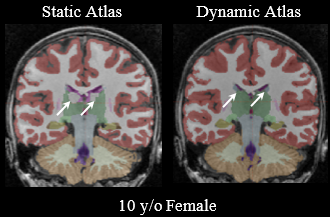 Cortechs.ai’ patented Dynamic Atlas™ technology provides automatic segmentation and volume measurements for patients ranging from 3-100 years, with robust segmentation and goodness-of-fit across all age ranges to the atlas.
Cortechs.ai’ patented Dynamic Atlas™ technology provides automatic segmentation and volume measurements for patients ranging from 3-100 years, with robust segmentation and goodness-of-fit across all age ranges to the atlas.
Similar to using a map of the world to identify where countries are located, an atlas of the brain indicates where specific anatomical structures are located. In the field of radiology, the process of identifying and labeling brain structures from diagnostic tools, such as MRI scans, is known as image segmentation.
MR image segmentation can either be performed by hand, which is tedious and time-consuming work, and requires a specialist, or by using automated image segmentation software. Traditionally, these image segmentation software solutions are based on a static atlas, which works very well for a large part of the population but shows limitations when the patient’s anatomy is too far from the generic norm or too far outside the standard age range.
In 2015, with the release of NeuroQuant® 2.0, Cortechs.ai introduced the Dynamic Atlas™, a new, unique approach for automatic segmentation, which creates a personalized atlas instantaneously based on patient specific covariates and prior anatomical knowledge derived from an extensive database. The prior knowledge is represented by the target image, likelihoods, and class priors, which are compiled over a large cohort of individuals.
Using proprietary algorithms, the patient’s observed data, which is comprised of original MR image data and derived data from image registration and segmentation, is further processed to predict the atlas parameters for an individual. An individual’s atlas parameters then form the basis of the personalized atlas allowing for the segmentation of virtually any patient instantly.
![]()
